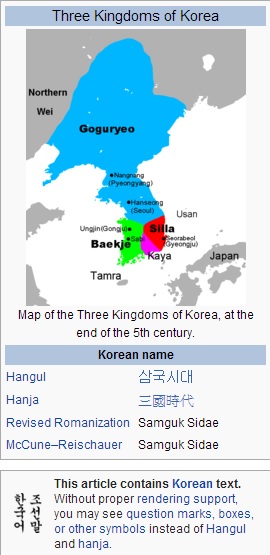Three Kingdoms of Korea

The Three Kingdoms of Korea (Hangul: 삼국시대; hanja: 三國時代) refer to the ancient Korean kingdoms of Goguryeo, Baekje andSilla, which dominated the Korean peninsula and parts of Manchuria for much of the 1st millennium. The Three Kingdoms period ran from 57 AD until Silla's triumph over Goguryeo in 668, which marked the beginning of the North and South States period (남북국시대) of Unified Silla in the South and Balhae in the North.
The earlier part of this period, before the three states developed into full-fledged kingdoms, is sometimes called Proto–Three Kingdoms of Korea.
Background
The name "Three Kingdoms" was used in the titles of the histories Samguk Sagi (12th century) and Samguk Yusa (13th century), and should not be confused with the earlier Chinese Three Kingdoms.
The Three Kingdoms were founded after the fall of Gojoseon, and gradually conquered and absorbed various other small states and confederacies. After the fall of Gojoseon, the Han dynasty established four commanderies in present Liaoning. Three fell quickly to the Samhan, and the last was destroyed by Goguryeo in 313.
The nascent precursors of Baekje and Silla expanded within the web of statelets during the Proto Three Kingdoms Period, and Goguryeo conquered neighboring state like Buyeoin Manchuria and chiefdoms in Okjeo, Dongye which occupied the northeastern Korean peninsula. The three polities made the transition from walled-town state to full-fledged state-level societies between 1st - 3rd century AD.
All three kingdoms shared a similar culture and language. Their original religions appear to have been shamanistic, but they were increasingly influenced by Chinese culture, particularly Confucianism and Taoism. In the 4th century, Buddhism was introduced to the peninsula and spread rapidly, briefly becoming the official religion of all three kingdoms.
Goguryeo高句麗
Goguryeo emerged on the north and south banks of the Yalu (Amrok) River, in the wake ofGojoseon's fall. The first mention of Goguryeo in Chinese records dates from 75 BCE in reference to a commandery established by the Chinese Han dynasty, although even earlier mentions of "Guri" may be of the same state. Evidence indicates Goguryeo was the most advanced, and likely the first established, of the three kingdoms.
Goguryeo, eventually the largest of the three kingdoms, had several capitals in al ternation: two capitals in the upper Yalu area, and later Nangrang (樂浪: Lelang in Chinese) which is now part of Pyongyang. At the beginning, the state was located on the border with China; it gradually expanded into Manchuria and destroyed the Chinese Lelang commandery in 313. The cultural influence of the Chinese continued as Buddhism was adopted as the official religion in 372.
The Empire was at its zenith in the fifth century during the rule of King Gwanggaeto the Great and his son King Jangsu in their campaign against China in Manchuria. For the next century or so, Goguryeo was the dominant empire in the Korean peninsula.Goguryeo eventually occupied the Liaodong Plains in Manchuria and today's Seoul area. Goguryeo controlled not only Koreans but also Chinese and other Tungusic tribes in Manchuria and North Korea. After the establishment of the Sui Dynasty and later the Tang Dynasty in China, the empire continued to suffer from Chinese attacks until conquered by an allied Silla–Tang forces in 668.
Baekje百濟
Baekje was founded as a member of the Mahan confederacy. Two sons of Goguryeo's founder are recorded to have fled a succession conflict, to establish Baekje around the present Seoul area.
Baekje absorbed or conquered other Mahan chiefdoms and, at its peak in the 4th century, controlled most of the western Korean peninsula. Under attack from Goguryeo, the capital moved south to Ungjin (present-day Gongju) and later further south to Sabi (present-day Buyeo).
Baekje exerted its political influence on Tamna, a kingdom that ruled Jeju Island. Baekje maintained a close relationship with and extracted tribute from Tamna. Baekje's religious and artistic culture influencedGoguryeo and Silla.
Buddhism was introduced to Baekje in 384 from Goguryeo, which Baekje welcomed. Later, Baekje played a fundamental role in transmitting cultural developments, including Chinese characters and Buddhism, into ancient Japan.
Silla新羅
According to Korean records, in 57 BCE, Seorabeol (or Saro, later Silla) in the southeast of the peninsula unified and expanded the confederation of city-states known as Jinhan. AlthoughSamguk Sagi records that Silla was the earliest-founded of the three kingdoms, other written and archaeological records indicate that Silla was likely the last of the three to establish a centralized government.
Renamed from Saro to Silla in 503, the kingdom annexed the Gaya confederacy (which in turn had absorbed Byeonhan earlier) in the first half of the 6th Century. Goguryeo and Baekje responded by forming an alliance. To cope with invasions from Goguryeo and Baekje, Silla deepened its relations with the Tang Dynasty, with her newly gained access to the Yellow Sea making direct contact with the Tang possible. After the conquest of Goguryeo and Baekje with her Tang allies, the Silla kingdom drove the Tang forces out of the peninsula and occupied the lands south of Pyongyang.
The capital of Silla was Seorabeol (now Gyeongju; "Seorabeol", "서라벌" in Hangul or "徐羅伐" in Hanja, is hypothesized to have been the ancient Korean term for "capital").Buddhism became the official religion in 528. The remaining material culture from the kingdom of Silla including unique gold metalwork shows influence from the northern nomadic steppes, differentiating it from the culture of Goguryeo and Baekje where Chinese influence was more pronounced.
Other states
Other smaller states or regions existed in Korea before and during this period:
Gaya confederacy, until annexed by Silla
Dongye, Okjeo, and Buyeo, all three conquered by Goguryeo
Usan (Ulleung-do) tributary of Silla
Tamna (Jeju-do) tributary of Baekje
Allied with China under the Tang dynasty, Silla conquered Goguryeo in 668, after having already conquered Gaya in 562 and Baekje in 660, thus ushering in the North-South states period with Later Silla to the south and Balhae to the north, when Dae Jo-young, a former Goguryeo military officer, revolted Tang Chinese rule and began reconquering former Goguryeo territories.
